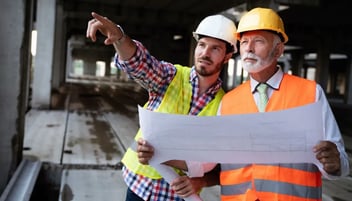3 Construction Trends That Will Shape the Industry in 2023
Big swings in supply and demand have presented many challenges for the trades in recent years.
Look for some of those construction trends to collide in 2023 to create even bigger waves in the construction industry.
Materials costs, supply chains, labor supply, inflation, government spending — these have been major stories since the pandemic, and we’re about to see what happens when some of those construction trends overlap.
Below are the three biggest construction trends we see impacting the industry in 2023 and beyond.
Table of Contents
Construction Trends: Inflation Will Be a Double-Edged Sword for Supply Chains
In 2021 and 2022, the demand for materials completely outstripped the ability of companies to supply. In some markets, prices skyrocketed seemingly overnight, even as literal boatloads of materials sat waiting in American ports for someone to unload them.
Inflation has begun to change that supply-demand dynamic. As prices everywhere go up, demand for certain things has begun to fall.
Aaron Morby at Construction Enquirer reports that lead times for many materials had fallen back to pre-pandemic levels. “Inflationary pressures rather than availability now present the main challenges for energy-intensive products such as glass, concrete, cement, PIR, plasterboard and bricks,” Morby writes.
As those dynamics work themselves out, prices for materials appear to be going in every direction at once. Case in point: Construction Dive’s Sebastian Obando reports that cement and concrete prices were rising while steel and lumber prices were falling. Meanwhile, the lead times for mechanical components were growing longer while they were easing for almost everything else.
This is what it looks like for a global economy to be in a state of flux. Plan for cost and supply chain volatility as you scope out work in the coming year.

There’s Going to Be More Work Than Workers
Anyone who hires in the construction sector knows how difficult it can be to put together a veteran field team. The pandemic, a Great Reshuffle and an aging workforce have all contributed to a labor crunch.
More on what that means for hiring in the next section.
From a big-picture perspective, a tight labor market puts contractors on the back foot precisely when new public works projects are opening up. McKinsey researchers Garo Hovnanian, Adi Kumar and Ryan Luby wrote about this in October 2022 in their analysis of the Infrastructure Investment and Jobs Act, or what’s more commonly referred to as the Bipartisan Infrastructure Law (BIL).
That law made available $350 billion in public infrastructure spending through September 2026. “The BIL is poised to escalate labor demand, starting with outlays flowing to states, agencies, and authorities to fund portfolios of projects,” the McKinsey researchers say.
“…A labor shortage may affect much more than just the construction sector—it could have far-reaching economic ramifications.”
To pile onto the challenge, voters gave the green light to several state-level infrastructure bills during the 2022 midterms. Key among those bills were a $4.2-billion statewide bond measure to fund environmental infrastructure projects in New York, and more than $15 billion in bond measures for school district projects throughout California. The team at Engineering News-Record has a good summary of all those bills.
For construction executives, all of this new infrastructure spending will only drive up the cost of and the competition for talented tradespeople.
Labor Costs Will Keep Rising
And so you can expect to pay a premium for good workers in 2023.
Derek Hunderman, director of sales and operations at electrical services firm Feyen Zylstra in Michigan, tells MiBiz that it’s a sellers market for skilled tradespeople: “Hiring in this marketplace in general is difficult, and I don’t think we’re alone. In the trades, electricians have been unicorns for a while, so that’s just continuing. Talent retention and workforce development becomes the secret sauce for those that will succeed.”
“Workforce development” in this context could go one of two ways. For companies that struggle to find veteran tradespeople, the next best option is often to hire inexperienced workers. But this creates risks around work output quality, as well as rework costs, as Cheri Hanes, head of the subcontractor default insurance risk engineering team at Axa XL, tells Business Insurance magazine.
For employers that do manage to find and build veteran teams, the cost of employee retention has gone up. Amy Stoldt, VP of people and culture at enterprise gifting company Snappy, tells Construction Dive that workers everywhere are beginning to ask for (and get offered) bigger benefits packages. These include things like student loan debt help and longer parental leave.
As we noted in September, many of the people applying for jobs today look for employers whose values align with their own. Those workers also look for stable work-life balances and roles in which they can find a purpose.
When hiring in a competitive labor market, you should speak to those needs in your job ads and your interviews. Tell candidates about the principles your company is built upon. If you have strong positions regarding sustainability, equity, diversity in hiring or community orientation, lead with those values.
The Bottom Line for Construction Executives
Put these construction trends together, and you see significant challenges emerge:
- Materials costs and supply chains will continue to ebb and flow.
- There will be new work coming from the public sector.
- It will get more expensive to hire, train and retain skilled tradespeople.
Good planning will be the key to weathering these challenges in 2023, and all good plans start with better project visibility. If your team struggles with job costing and project management, have a look at how eSUB Cloud can bring structure and insights to your upcoming projects.
Images by: C Dustin, Jeriden Villegas



